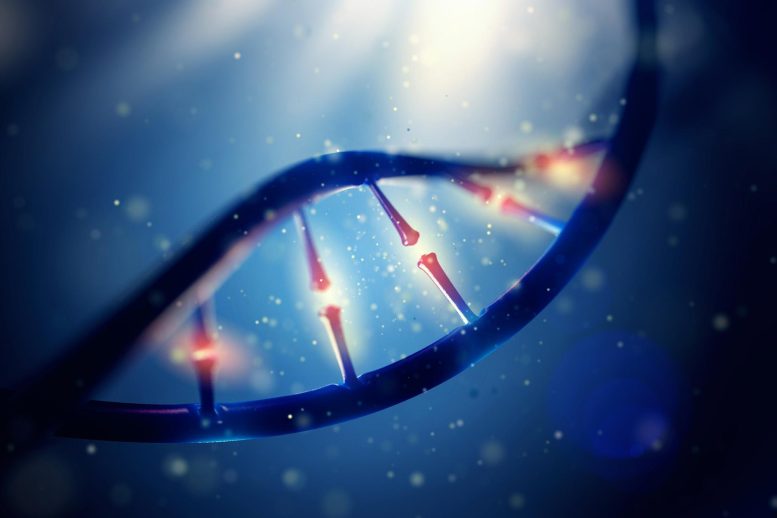
New research reveals why some people with disease-causing genes have no symptoms.
Researchers at
” data-gt-translate-attributes=”({“attribut=”” tabindex=”0″ role=”link”>Columbia University challenged a fundamental principle of genetics, discovering why some individuals carrying disease-related genes remain asymptomatic.
Biology students typically learn that every cell in the body (except sperm and eggs) contains two copies of each gene – one inherited from each parent – and that both copies contribute equally to cellular function.
However, this new study reveals that some cells may exhibit a bias, selectively inactivating a parent’s copy of a gene. Although this phenomenon was identified around ten years ago, the Columbia team has now demonstrated its potential impact on the progression of the disease. By studying specific immune cells in typical individuals, researchers found that these cells inactivated the maternal or paternal gene copy in about 1 in 20 genes used by the cells.
“This suggests that there is more plasticity in our
” data-gt-translate-attributes=”({“attribute=”” tabindex=”0″ role=”link”>DNA than we previously thought,” says study leader Dusan Bogunovic, professor of pediatric immunology at Columbia University’s Vagelos College of Physicians and Surgeons.
“So in certain cells in your body, one in twenty genes may represent a little more mom, a little less dad, or vice versa. And to make things even more complicated, it can be different in white blood cells than it is in kidney cells, and maybe it can change over time.
The results were published on January 1 in the journal Nature.
Why it matters
The new study explains a long-standing puzzle in medicine: Why do some people who inherit a disease-causing mutation have fewer symptoms than others with the same mutation? “In many diseases, we will see that 90% of people with a mutation get sick, but 10% of people with the mutation don’t get sick at all,” says Bogunovic, a scientist who studies children with disorders rare immunological disorders at university. Columbia University Irving Medical Center.
Using an international team of collaborators, the researchers studied several families with different genetic diseases affecting their immune systems. In each case, the pathogenic copy was more likely to be active in diseased patients and suppressed in healthy relatives who had inherited the same genes.
“There was speculation that this bias toward one copy or another could explain large differences in the severity of a genetic disease, but no experimental evidence existed until now,” says Bogunovic .
Although the current work only focused on immune cells, Bogunovic says the selective bias toward the maternal or paternal copy of a gene did not only affect genes related to the immune system. “We don’t see a preference for immune genes or any other class of genes, so we think this phenomenon may explain the wide variability in disease severity that we see with many other genetic diseases,” he says, adding “this could just be the tip of the iceberg.”
This phenomenon could help explain diseases accompanied by flare-ups, such as lupus, or those that appear following environmental triggers. It could also play a role in cancer.
Changing the future of genetic disease treatments?
The study results suggest a whole new paradigm for diagnosing and perhaps even treating hereditary diseases.
The researchers propose expanding the standard characterization of genetic diseases to include patients’ “transcriptotypes,” their patterns of genetic activity, in addition to their genotypes.
“This changes the paradigm of testing beyond your DNA and your
” data-gt-translate-attributes=”({“attribute=”” tabindex=”0″ role=”link”>ARNwhich, as we showed in our study, is not the same in all cell types and can change over time,” explains Bogunovic.
If researchers can identify the mechanisms behind selective gene silencing, they may also be able to treat genetic diseases in a new way, by changing a patient’s gene expression pattern to delete unwanted copy. While emphasizing that such strategies are still far from being used in the clinic, Bogunovic is optimistic: “At least in cell culture in the laboratory we can do it, so such manipulation is something that could transform the genetic disease of ‘a person into a non-disease, assuming we succeed.
Reference: “Monoallelic expression may govern the penetrance of inborn errors of immunity” by O’Jay Stewart, Conor Gruber, Haley E. Randolph, Roosheel Patel, Meredith Ramba, Enrica Calzoni, Lei Haley Huang, Jay Levy, Sofija Buta , Angelica Lee, Christos Sazeides, Zoe Prue, David P. Hoytema van Konijnenburg, Ivan K. Chinn, Luis A. Pedroza, James R. Lupski, Erica G. Schmitt, Megan A. Cooper, Anne Puel, Xiao Peng, Stéphanie Boisson-Dupuis, Jacinta Bustamante, Satoshi Okada, Marta Martin-Fernandez, Jordan S. Orange, Jean-Laurent Casanova, Joshua D. Milner and Dusan Bogunovic, December 32, 2024, Nature.
DOI: 10.1038/s41586-024-08346-4
The study was funded by the
” data-gt-translate-attributes=”({“attribute=”” tabindex=”0″ role=”link”>National Institutes of Health.


